Baked Pomfret is an Indonesian dish where the whole fish is baked with an aromatic marinade of cashew nuts and ginger. It is a tantalizing recipe that calls for three types of ginger, sambal, and other spices that give an additional kick to the whole fish. This tender, flaky and aromatic fish made without any oil is quite easy to prepare. The fish can be marinated the previous night and baked in large batches for any formal or casual dining experience at home.
Baked Pomfret, especially fish baked in banana leaves, is a perennial favorite in South and Southeast Asian cooking. From Indonesia to India, grilling or baking in banana leaf is a time-honored tradition, especially when it comes to seafood.
The recipe below for Baked Pomfret is an original, mélange recipe based on my experiences from India, Malaysia, Singapore, and Indonesia. It is reflected not only in the style of preparation but also in my use of ingredients. I have tried this method of preparation at hotels and resorts from the Arabian to the South China Sea. To be honest, they are all different, not only because of the fish but also because of the ingredients. But they all had that one common theme: freshly baked, spiced fish that tasted of warm seas, infused with the tropical tartness of freshly ground spice.
My Baked Pomfret is the whole gutted fish that has been baked in an aromatic marinade of three types of ginger, sambal, and other spices. I promise you that you will think that you are in the tropics. Served on a bed of jasmine or basmati rice, this tender, and aromatic fish is made without using any oil in the preparation and relies instead on the moisture from the fish and the marinade to gently flavor while cooking. The fish can be marinated the previous night and baked in batches.
You must have seen or bought sambal from Asian shops. What surprised me completely was that pretty much most Southeast Asian families had their own recipes. Some used different types of chilis, while others used palm sugar instead of jaggery, most used shrimp paste but added a splash of fish sauce or kaffir lime instead of regular lime, to say nothing of ratios. My own recipe has its origins from my husband’s side, although I think I have moderately improved on it. Nonetheless, the sambal is something that cannot be ignored. You can, of course buy it but like everything else, you can experiment and modify it to suit your taste.
Pomfret as a variety of fish species:
To begin with, let’s talk about the ‘pomfret’ in the Baked Pomfret first because this is a fishy story! Sorry, I couldn’t help the pun. To be candid, the colloquial use of the phrase ‘pomfret’ covers a variety of fish species:
- Butterfish: The variety that is popular in Asian cuisine is butterfish. There are a couple of varieties, but the more common one is the white or silver pomfret which can be found from the Arabian Sea to the South China Sea and as far north as Japan.
- Pompano: Pompanos are highly prized deep-bodied, toothless fish. The Black, Florida (or Golden), and Paloma Pomfrets are good examples of that, and they are found along shores in warm water locations.
- Pomfret: The actual pomfret is the Pacific pomfret, which can be found from Japan to Peru.
For the purposes of this Baked Pomfret recipe, these fish are interchangeable. These seawater fish with a single bone have a flat body and forked tail. As with most pomfrets, these are best-served whole, after removing the internal organs.
Why pomfret is the perfect choice for baking:
Unlike most other saltwater fish, the pomfret:
- Does not have a strong odor
- Is low in calories and fat
- Is rich in protein, which helps reduce the risk of cardiovascular diseases
- Contain high amounts of omega 3 fatty acids
Ginger as a key ingredient:
As you could imagine, growing up in Chennai, ginger was a common ingredient. I grew up knowing the distinction between young and old ginger and their distinct uses. From accentuating tea to being used in pickles, ginger is a staple. The spice possesses anti-inflammatory properties and is an essential source of oils, protein, calcium, iron, vitamin C, choline, folic acid, manganese, and vitamin B3. But the distinction between old and young ginger is less well-known.
Differences between fresh and old ginger and the galangal:
- Young, spring or fresh ginger is moist, juicy, and plump, and has a slight pink tinge. Its skin is extremely thin, and you can eat it raw. It has a sharp but mildly spicy flavor.
- Old or spicy ginger is drier and more fibrous. It is a much spicier elder to young ginger because of the increased presence of the compound gingerol, which is a potent antioxidant that reduces inflammatory enzymes. The increased presence of gingerol is attributed to the fact that this compound is concentrated in the skin and therefore, the tougher and more mature the root is, the spicier it will be.
- Galangal is of course, a different ballgame. Although many people use old ginger as a substitute for galangal, it should be noted that there are differences in form and flavor.
- Galangal is more prevalent in Southeast Asian cooking than Indian cuisine. While ginger is a mainstay of stir-fries and curries of China and India, the galangal is used to flavor the distinct soups and sauces of Indonesian, Malaysian, and Thai cuisines.
- While ginger (especially old ginger) can be powdered, I’ve always believed that galangal loses some of its flavor profile when subjected to powdering. It is a spice that is tastes best when fresh and in small segments.
- Galangal has a piney and citrusy hue to its flavor, whereas ginger tends to be sharper and sweeter.
What makes my recipe distinct is that I use all three: old and young ginger, as well as galangal in preparing my Baked Pomfret. As I said, this combination of both South and Southeast Asian ingredients gives my baked fish a sharp, sweet, yet citrusy bouquet when you take it out of the oven. Complimenting that is my very own sambal.
Here’s why I think you’ll love the Baked Pomfret:
- Easy: The recipe itself is extremely simple and straightforward and relies on the marinade to provide the flavor uplift.
- Healthy: Not only is the pomfret a healthy and sustainable fish, but there’s also no oil in the marinade to offset the natural Omega 3 oils that you’re getting from the fish.
- No mess: While I have previously made this with banana leaves, which add a certain fresh taste to this dish, if you use a baking foil, there’s not much to clean up, especially since the marinade does the work for you.
- Tantalizing as I have used spices that complement the flavor profile of pomfret.
- Aromatic with three types of ginger
- Flaky and tender fish without the need for a sauce on the side
- Better than restaurant-quality dish at home
Other methods of cooking the whole pomfret:
- Bake by wrapping the whole fish with the marinade in banana leaf. As I’ve previously said, you can make this dish by replacing the foil with a moistened banana leaf. Before you get concerned, yes, the banana leaves are porous (unlike foil), so you should expect that the juices may seep out, depending on how you wrap this fish. Try placing this in an ovenproof glass casserole or something with sides, so that the juices don’t end up at the bottom of your oven. I enjoy baking with banana leaves because it allows the protein to breathe and absorb some of that rich banana flavor. If you’re concerned about how to find banana leaves, most Asian supermarkets will carry the fresh leaves depending on the availability. Check to see that they are a deep vivid green, with little or no browning or holes, and that they have smooth and rounded edges.
- Steam: If you don’t want to bake, you could try steaming it. This is, of course, probably the healthiest way to eat this fish. A word of caution, when you wrap the whole fish in foil or banana leaf, be sure to form a vent for the steam to escape. For a more Asian feel, try a bamboo steamer. I absolutely adore this method as well.
- Bake uncovered on a greased and foil-lined tray or broiled for 20 minutes
- Pan-fry or pan-sear with little oil in a non-stick griddle
- Grill: If you want to grill or pan fry or sear this fish, you should add some oil to it and also thicken the marinade. While grilling and/or searing this fish cooks the marinade and the fish, the additional marinade provides a fragrant and smokey flavor that enhances this simple dish.
Other types of fish to substitute with this recipe:
- Tilapia
- Milk fish
- Red snapper
- Black pomfret
- Cod
- Grouper
The choice of fish will not affect the recipe and but will change the flavor profile. But the dish will be equally yummy!
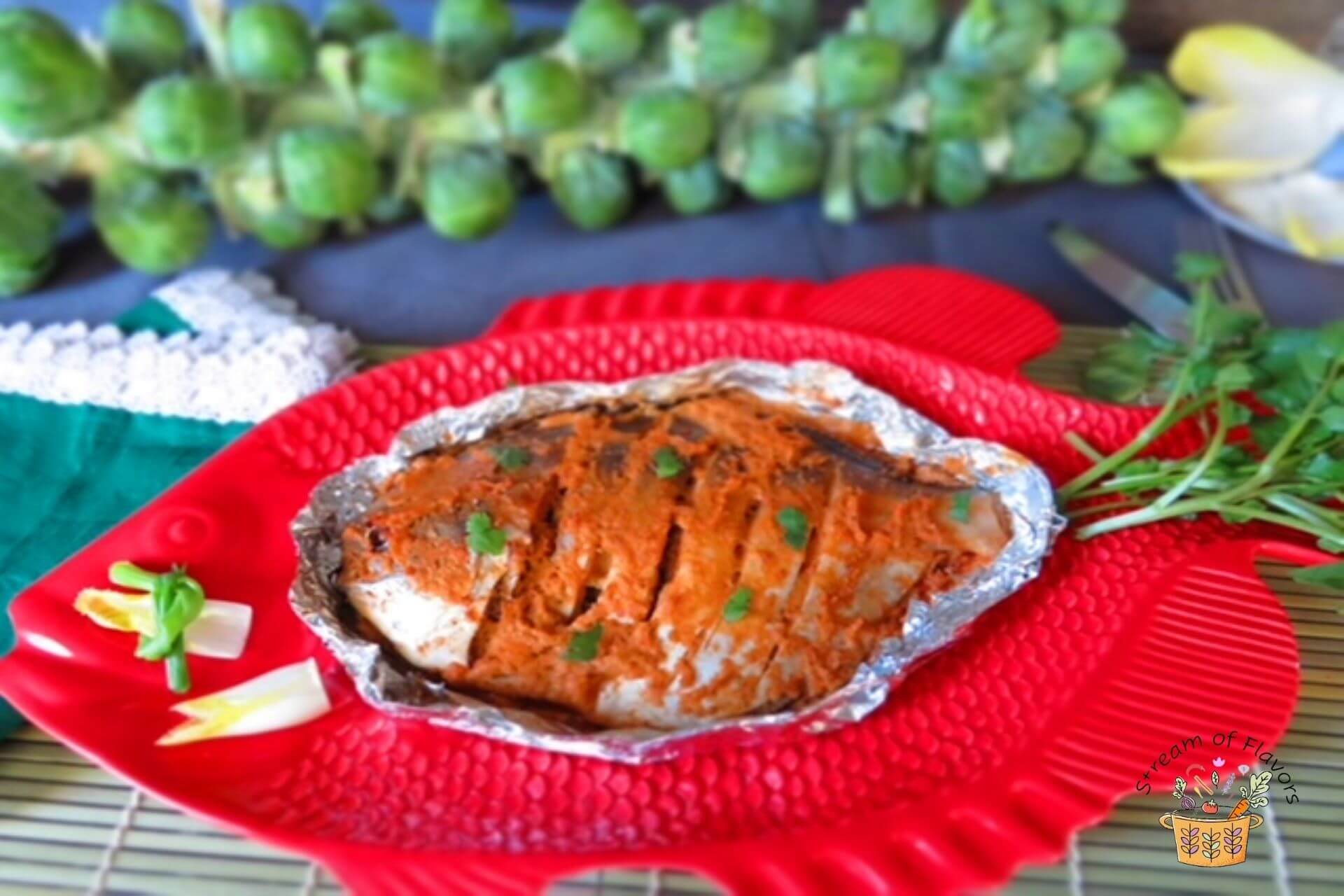
How to clean whole pomfret:
Large Asian stores offer fish cleaning services free of charge. However, I have included instructions on how to clean a whole fish.
- Scale the fish and trim or cut the fins and tail.
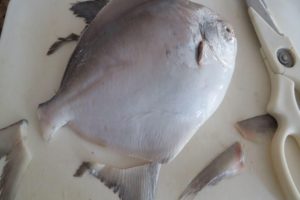
- Make an incision using a sharp knife by the lower fin. Use a spoon to scoop out the innards and gut the fish.
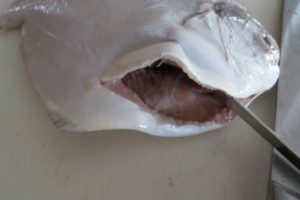
- Score the fish and make vertical or diagonal cuts along the sides of the fish by going deep down to the bones.
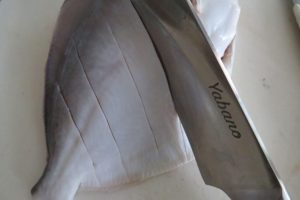
How to make the Baked Pomfret:
- Clean the pomfret, make incisions, and keep aside.
- Place all the ingredients for the marinade in a food processor.
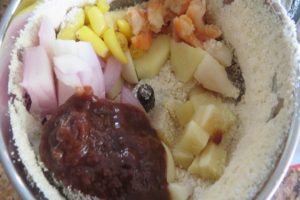
3. Pulse the ingredients to a fine paste. Add very little water, if needed.
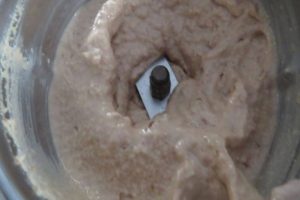
4. Slather the marinade on the whole pomfret. Work the marinade into the incisions. Marinate the fish overnight in sealed Ziploc bags in the refrigerator. The following day, wrap each fish with foil. Preheat oven to 3500 F.
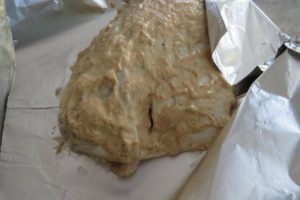
5. Place the whole fish on a greased baking tray. Bake for 30 minutes.
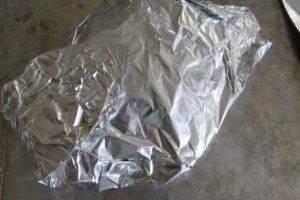
6. Then, remove the tray from the oven and open the foil. Broil the fish for 15 minutes at 4500F. Do not flip the fish or add any oil or fat.
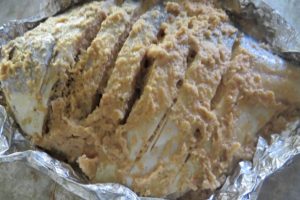
7. Garnish the Baked Pomfret with endives and watercress. Serve hot in a fish tray.
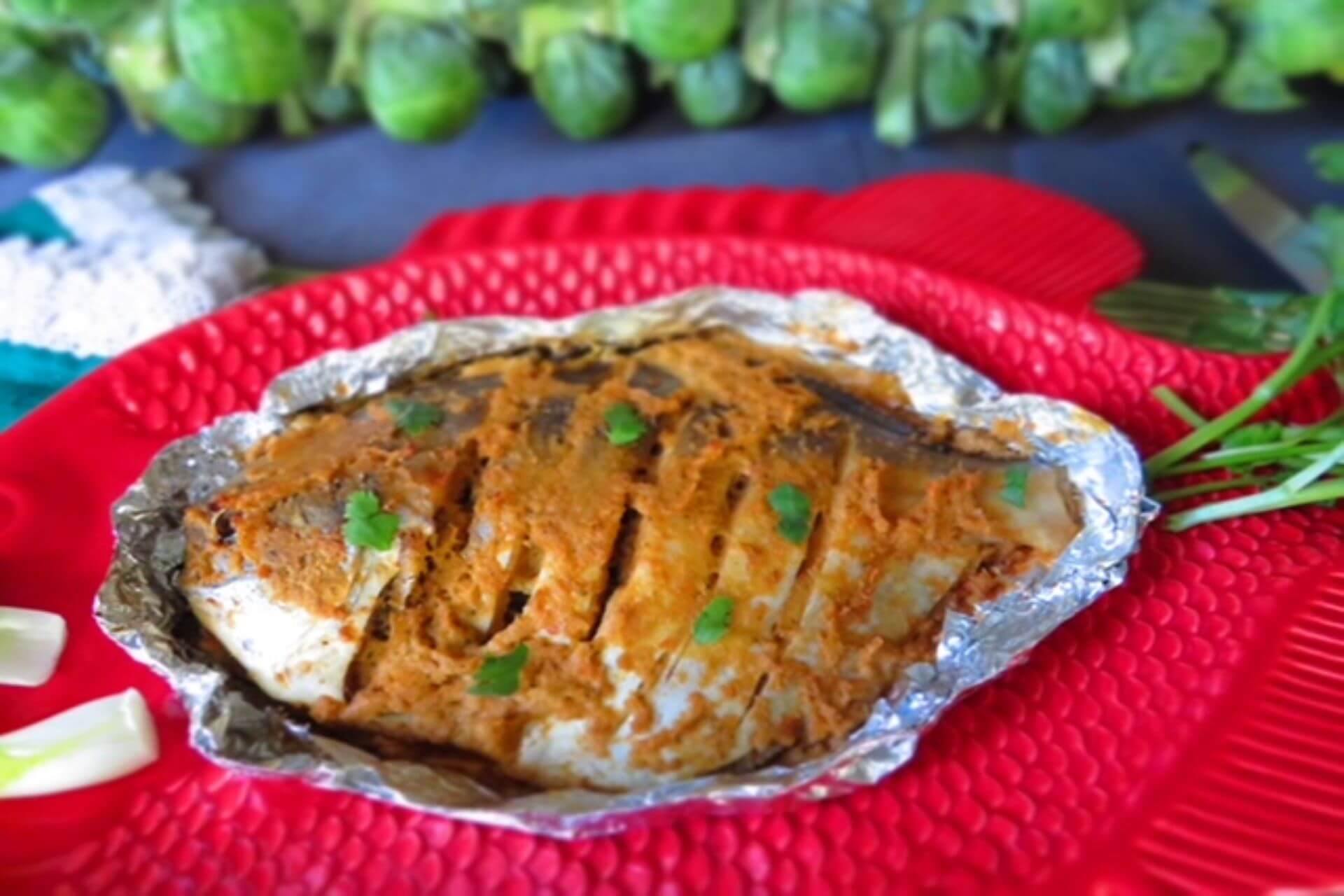
1. Pack the fish well in foil and seal it while baking. This is to ensure that the flavor from the juices steep into the fish.
2. There is no need to flip the fish over while baking. To prevent the fish from falling apart while serving, I placed the same foil on the fish serving tray.
3. I like my fish well done. However, do not overcook the fish. The internal temperature of the fish must be 145-degree F on a meat thermometer.
4. I did not use any oil or fat for baking the fish. Feel free to use a few drops of olive oil if you like.
Baked Pomfret serving suggestions:
I served the Baked Pomfret on a bed of Basmati rice. I like serving it with a side of salad and a cool fruit drink like the Healthy Mocktails.
Other fish recipes that you might love to try:
Baked Pomfret
Equipment
- Food processor, oven
Ingredients
- 3 white pomfret
- ¾ cup cashew nut powder
- 1 tbsp fresh ginger
- 1 tsp galangal
- 1 tsp old ginger
- 1 shallot
- 6 Thai yellow chili
- 1½ tsp salt
- 4 dried shrimp soaked
- 1 tbsp tamarind
- 1 tsp coconut palm sugar
- 1 tomato chopped
- 1 clove garlic
- 1 sprig cilantro
Instructions
- Clean the pomfret, make incisions, and keep aside. (See blog post on how to clean the pomfret)
- Place all the ingredients for the marinade in a food processor.
- Pulse the ingredients to a fine paste. Add very little water, if needed.
- Slather the marinade on the whole pomfret. Work the marinade into the incisions. Marinate the fish overnight in sealed Ziploc bags in the refrigerator. The following day, wrap each fish with foil. Pre-heat oven to 3500 F.
- Seal the whole fish with foil and place them an inch apart on a greased baking tray. Bake for 30 minutes.
- Then, remove the tray from the oven and open the foil. Broil the fish again for 15 minutes at 4500F. Do not flip the fish or add any oil or fat.
- Garnish the fish with endives and watercress. Serve hot in a fish tray.
Notes
- The whole fish need not be flipped over during baking.
- If you cannot find galangal or fresh ginger, then use old ginger.
- Dried shrimp is essential for this dish and cannot be omitted.
- Use any bird's eye chili or dried chilis.
- Cashew nuts are the main base for this creamy marinade. Feel free to use macadamia nuts instead.
Nutrition


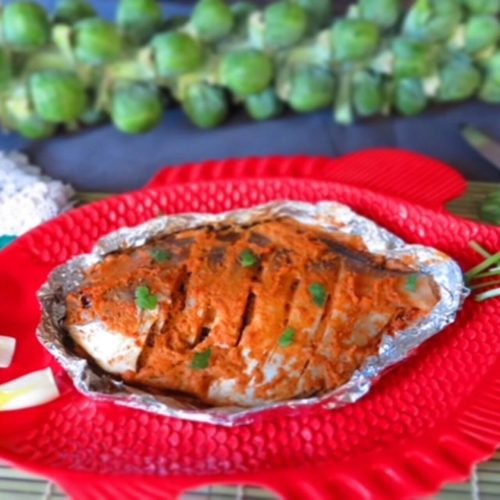
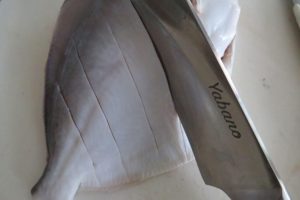
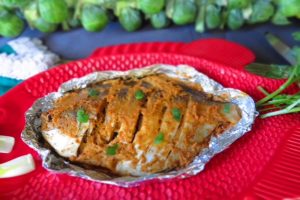





















this is such an impressive recipe!
This spice rub is really good!